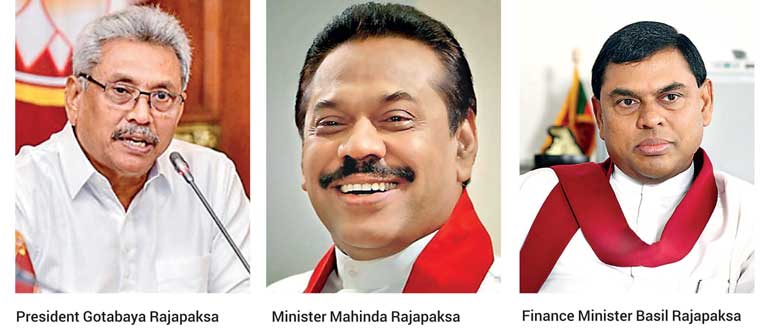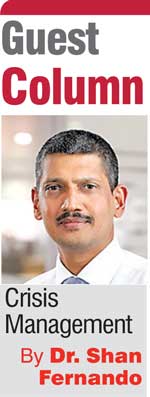Sunday Dec 14, 2025
Sunday Dec 14, 2025
Thursday, 27 January 2022 00:43 - - {{hitsCtrl.values.hits}}

Sri Lanka was able to borrow money from the IMF/World Bank and multilateral agencies at low interest rates for a very long time. So, we learnt to live on borrowed money without properly embarking on much needed economic reforms. Money was freely available, so we borrowed heavily at concessionary rates. We did not feel the need for financial discipline since money was freely available.
However, after attaining middle income country status, we were no longer eligible to borrow on concessionary rates and instead we had to borrow money at commercial rates from the market. Although money was more expensive now, we did not act prudently. Instead, we continued to borrow heavily even at high commercial rates. In 2004, commercial loans amounted to only 2.5% of Sri Lanka’s foreign loans, but by the end of 2020, 51% of the country’s foreign loans were commercial borrowings, most of which were International Sovereign Bonds (ISBs).
Further, part of this borrowed money was spent on grandiose mega projects and on projects that made no economic sense such as the ‘Nelum Pokuna’ theatre and a convention hall in Hambantota, etc.
We should have borrowed money prudently and spent that money on upgrading the skill levels of our people and on quality education, etc. Such projects would have made economic sense. 
Now we are saddled with a heavy debt burden and debt servicing has become a problem due to our low foreign exchange reserves and low credit rating of the country. The low credit rating makes new foreign borrowings even more expensive. Therefore, rolling over our debt is now more difficult and more expensive.
We are now facing a foreign exchange crisis too. That is due to our dollar outflows far exceeding our dollar inflows. Over the years we had not embarked on a proper export promotion strategy. Instead, we had experimented with failed strategies like import substitution. Therefore, our export products have not diversified adequately. This is the main reason for inadequate export market diversification too.
Sri Lanka had not implemented a proper industrial strategy consistently over a long period of time. As a result, the country’s industrial sector has not taken off. Therefore, while other countries diversified their export baskets, moving from apparel exports to electronic and electrical sector, etc., Sri Lanka has been stuck with apparel and not diversified her export basket adequately.
Due to inadequate export product diversification Sri Lanka’s relative earnings from exports has remained low. However, Sri Lanka’s import expenditure has far outpaced her export earnings, thereby leading to wide trade deficits. Thus, Sri Lanka’s dollar outflows have far exceeded her dollar inflows and this has led to a continuous depreciation of the Sri Lankan rupee. Now there is a wide disparity between the official exchange rate and the unofficial rate. While the official exchange rate is around Rs. 200-202 per US dollar, the unofficial rate is as high as Rs. 245-250 per US dollar.
On the fiscal side, the Government’s expenditure is far more than its revenue. In other words, the Government’s budget deficit is high and it recorded 11.1% of GDP in 2020 and 2021. High and continuous fiscal deficits have been the root cause of higher levels of public debt too. Sri Lanka’s public debt as a percentage of GDP recorded 101% in 2020.
The interest cost on public debt alone amounts to 70% of Government revenue. Salaries, wages and pensions amount to 77% of Government revenue. Therefore, even to service the debt the Government has to borrow. Out of the total debt, domestic debt accounts for 60% while the balance 40% is accounted for by foreign debt.
Sri Lanka’s debt service payments on foreign debt amount to around $ 4-5 billion each year until at least 2025. However, the country’s gross official reserves amounted to only $ 1.6 billion at end-November, 2021 and these reserves were sufficient to support only a month’s imports. Subsequently, the Government made use of a Chinese swap facility amounting to $ 1.5 billion and managed to prop up the reserves to end the year 2021 with reserves amounting to $ 3.1 billion. Out of these reserves, the Government settled a dollar bond amounting to $ 500 million in January, 2022. This shows how precarious the country’s debt situation is. There is another dollar bond settlement amounting to $ 1 billion which will be due in July, 2022. Therefore, the country will have some breathing space till then to rebuild her reserve buffers and to try and restructure her debt obligations.
What should have been done
The internal armed conflict in Sri Lanka came to an end in May, 2009. In the post-war period Sri Lanka pursued a massive infrastructure drive. The Hambantota harbour was one such project. However, it was not funded by FDI, but by borrowed money. Ideally in the post-war period Sri Lanka should have focused more on export promotion. Exports generate much-needed foreign exchange. Sri Lanka should have concentrated on promoting tourism, IT industry, and electronic and electrical sector, etc. which are sources of valuable foreign exchange. If we had diligently promoted these sectors, we would not have been facing a foreign exchange crisis today.
Another area we should have concentrated on is attraction of FDI. However, if we were serious about attracting FDI we should have concentrated on appropriate skills development/human capital development. Foreign investors are interested in skilled labour. For example, we should have focused on generating the required number of IT graduates each year.
In the post-war period we should have paid more emphasis on the promotion of tradables. However, the Government focused more on non-tradables such as mega infrastructure projects funded by not FDI but borrowed money. By promoting non-tradables instead of tradables, the Government created an anti-export bias. What we mean by tradables is exports and imports. When promoting exports, a certain amount of imports will also have to be accommodated as intermediate goods imports required for the export industries.
Further, if we can import certain goods at a cheaper price rather than producing those goods locally, then it makes sense to import such goods rather than trying to produce them locally. On the other hand, if we try to produce such goods locally under a policy of import substitution, we will only be promoting inefficient industries at the expense of promoting exports, and resources will be diverted to such inefficient industries rather than using such resources to produce export goods and services exports. This misallocation of resources is what we mean by the phrase ‘anti export bias’.
Way forward
1) Sri Lanka should enter into a program with the IMF. The usefulness of such a program is not limited to the money that we will receive from the IMF. The other benefits that will accrue to Sri Lanka from such a program outweigh the monetary benefits. A program with the IMF will send a signal to prospective investors and Sri Lanka’s borrowing sources that the country is back on a program aimed at financial discipline and macroeconomic stability. Depending on the successful implementation of the program, rating agencies may consider upgrading Sri Lanka’s credit rating and/or rating outlook. Such an upgrading will help the country to access foreign funds at more favourable interest rates. A program with the IMF will also focus on reducing the budget deficit. Such a reduction of the budget deficit, if continued consistently over a number of years, will eventually help the country to keep its public debt under control.
2) Other than an IMF program, Sri Lanka may also have to go for a debt restructuring program. Such a program will give the country some breathing space to put the house in order and to find the resources to repay her debt. The process of debt restructuring will take some time. Therefore, in the interim, the Government will have to obtain some bridging finance to meet the import cost of food, fuel, medicine and such other essential goods.
3) Other than the apparel industry and workers’ remittances, tourism, IT industry and electronic and electrical sector will be key industries that will help to generate much needed foreign exchange earnings. Therefore, concerted efforts should be made to promote those industries. The excessive rates charged from tourists at tourist attraction sites should be reviewed and tourists should be afforded better facilities at such sites.
4) Every effort should be made to boost non-debt creating foreign exchange inflows such as FDIs.
5) The Government should implement a program of revenue driven fiscal consolidation.
6) Export promotion will have to be pursued assiduously and consistently over a long period of time. Therefore, the anti-export bias will have to be eliminated.
7) Good governance should be emphasised and corruption will have to be eradicated from all public institutions. This is a necessary condition to creating a conducive environment for attraction of investments including FDIs.
8) A talent pool will have to be created so that there will be a steady supply of skilled labour which is required for an emerging economy. Such a talent pool will be important in attracting FDIs too. Therefore, skills development/human capital development will have to be pursued assiduously and consistently.
(The writer counts nearly three decades of experience in the field of economic research in the private sector. He has earned a BA (Hons) in Economics, an MA in Economics and a PhD in Economics at the Department of Economics of the University of Colombo. He can be reached at [email protected].)